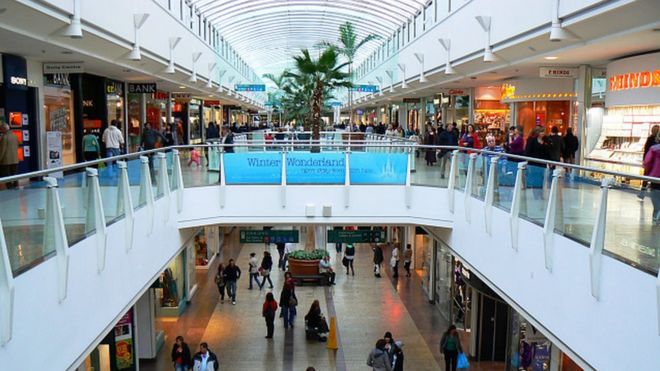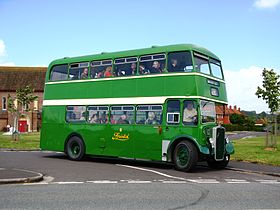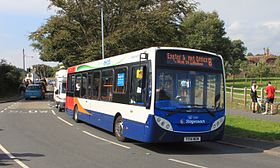 Cribbs Causeway
Cribbs CausewayCribbs Causeway is a road in South Gloucestershire, England, just north of Bristol, which has given its name to the surrounding area, a large out-of-town shopping centre, including retail parks and an enclosed shopping centre known as The Mall. Cribbs Causeway road is situated west of Patchway, although in the civil parish of Almondsbury.
The road runs from the northern edge of Bristol at Henbury to a point just beyond the M5 junction 17. It now forms parts of the A4018 and B4055. The primary access routes to the shopping centre are the A4018 from Bristol, the M5 motorway and Hayes Way link to the A38.
The Hazel Brook rises at Cribbs Causeway, flowing southwards through Blaise Castle estate, before joining the River Trym.

Image: Cribbs Causeway shown on the North Bristol map.
History
It is often said that the name of the road is named after Tom Cribb, who was once a famous bare-knuckle boxer from the Bristol area. Although this was proved wrong in the 1960s by the discovery of a map showing the current name dated to four years prior to his 1781 birth. The book's author goes on to speculate that the true origin of the name may be from Crybe's dwelling (Crybe being a personal name), or from crib – a manger or hovel. But all that we can truly glean from this is that the causeway - i.e. the Roman road - was named for a family with the surname Cribb (which may or may not have been closely related to the boxer's family: he was from Hanham on the opposite side of Bristol). This local family was probably also commemorated in the smallholding called Crybescroft which existed in Henbury in 1281.
Rumours would have us believe that Cribbs Causeway is a route of a Roman road from Sea Mills to Gloucester. It later became the route of a turnpike from Bristol to New Passage. In the 20th century it was part of the main road from Bristol to the Aust Ferry, until the Severn Bridge opened in 1966. In the early 1960s it was upgraded to an A road (the A4018), and linked with the New Filton Bypass to the A38 north of Patchway. In 1971 the New Filton Bypass was incorporated into the M5 motorway, and the motorway junction transformed the area. In 1976 Carrefour was granted planning permission to build a hypermarket (now the Asda store) near the junction. Development of retail parks followed, and in 1998 the Mall was opened.
The Mall
The two storey mall was opened in 1998, it comprises 130 shops on both levels, although some of the large stores occupy more levels. Major stores include anchors John Lewis and Marks & Spencer, plus Boots, H&M, Next, River Island and Topshop/Topman. During 2013, the centre housed the Gromit Unleashed Exhibition and Store and also hosted the charity auction that took place after the arts trial had concluded. Global corporations such as Apple Inc, Samsung, Bose Corporation and Tesla Motors. In the atrium on the upper level of the Mall is the dining court which is home to various chain outlets such as another KFC (the other is located at the Venue), McDonald's, Carluccio's, Pizza Hut, Nando's, Spudulike, Krispy Kreme and more.
Within the heart of The Mall it has a large fountain with a water display. Money thrown into the fountain is donated to local charities, the company reports it raises in excess of £10,000 a year for local charities.[5][6] The fountain has many copper pipes that pump water out in repeated patterns and either into the middle, or towards the middle, where another pipe shoots water high into the air every 5–10 minutes at approximately 10 – 15 metres. The height of the water can be adjusted in case an advertisement or if an object is above it, such the centre's Christmas tree, so it cannot get wet. There are also another few fountains outside the main entrance, where water falls down a pyramid shape and along some steps on each side of the fountain, leading to a path with a stream in the middle that isn't regularly used. At the end of the stream, that stretches to the main entrance of the main car park, are another few fountains that are visible to anyone entering the car park, and the water flows down a wall into drains.
When The Mall celebrated it's tenth year of opening, the company announced a five million pound refurbishment of the food court, completed in two stages with completion in May 2009.
The primary access routes are the M5 Junction 17, Hayes Way to the A38 and A4018. The Mall is one of the major shopping centres in the Bristol area, the other being Broadmead, the location of The Galleries, Bristol and Cabot Circus.
Retail parks
There are two retail which are warehouse style shops with entrances from outside. Cribbs Causeway Retail Park is a group of large shops off Lysander Road containing Argos, Currys PC World Megastore, Harveys, Magnet Kitchens, Next Home, Oak Furniture Land, SCS, Smyths and Wren Kitchens. Nearby is Centaurus Retail Park containing Carpetright, Dreams, Halfords, Hobbycraft, Maplin Electronics, T.K. Maxx, and B&M (opened 2nd May 2015).
Other stores
There are several other stores which include the United Kingdom's first Asda Wal*Mart Supercentre, which was originally built by the French hypermarket chain Carrefour in the late 1970s. Then when Carrefour pulled out of the UK it sold all of its stores, including the Bristol hypermarket, to the Dee Corporation which owned the Gateway store chain. Then Gateway sold all of its large format stores to Asda in 1989, and it became an Asda hypermarket. Then after the sale of Asda by its management to Walmart in July 1999, it became the first Asda Wal*Mart Supercentre in July 2000. The store has since had yet another major refurbishment and has been rebranded as an Asda Supercentre and the Walmart branding has been removed. This is also the location of the first Morrisons supermarket in the south west of England which opened in September 2003.There is also a B&Q DIY store which also houses a Furniture Village, DFS, Makro, Toys "R" Us and Wickes.
Hollwood Lane, which passes under the M5 motorway, is the Cribbs Business Centre. A Bang & Olufsen store is located on Cribbs Causeway and Topps Tiles is located on Lysander Road. The Lamb & Flag, a Harvester pub, is also located on Cribbs Causeway.
The Venue
entertinment complex featuring a 12 screen Vue cinema, Hollywood Bowl a ten-pin bowling alley, Anytime Fitness and eateries, Bella Italia, Burger King, Chiquitos, Frankie & Benny's, KFC, Las Iguanas, PizzaExpress and T.G.I. Friday's.
































